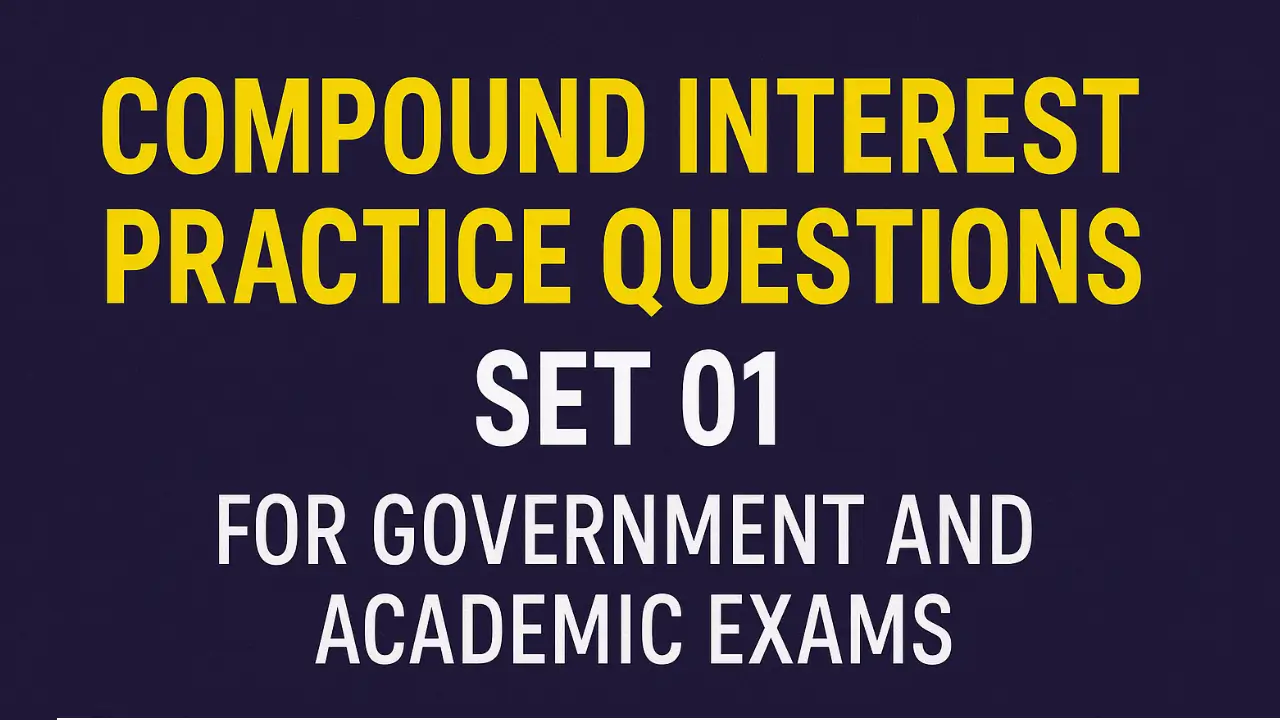Q11. What is the compound interest on ₹15,000 for 2 years at 6% per annum compounded annually?
A) ₹1,800
B) ₹1,854
C) ₹1,890
D) ₹1,920
Correct Option is: B) ₹1,854
Explanation:
Amount = ₹15,000 × (1 + 0.06)²
= ₹15,000 × 1.1236 = ₹16,854
Compound Interest = ₹16,854 − ₹15,000
= ₹1,854
Q12. What principal will amount to ₹5,832 in 2 years at 8% per annum compounded annually?
A) ₹5,000
B) ₹5,200
C) ₹5,400
D) ₹5,600
Correct Option is: A) ₹5,000
Explanation:
Amount = P × (1 + 0.08)²
= P × 1.1664
= ₹5,832
P = ₹5,832 ÷ 1.1664 = ₹5,000
Q13. What is the compound interest on ₹10,000 at 12% per annum for 1.5 years, compounded annually?
A) ₹1,872
B) ₹1,896
C) ₹1,920
D) ₹1,925
Correct Option is: A) ₹1,872
Explanation:
Year 1: ₹10,000 × 0.12 = ₹1,200 → Amount = ₹11,200
Half-year: ₹11,200 × 0.06 = ₹672
Total Amount = ₹11,872
CI = ₹11,872 − ₹10,000 = ₹1,872
Q14. If ₹8,000 is lent at 5% per annum compounded quarterly for 1 year, what is the amount?
A) ₹8,450
B) ₹8,470
C) ₹8,408
D) ₹8,500
Correct Option is: C) ₹8,408
Explanation:
Quarterly rate = 5% ÷ 4 = 1.25% = 0.0125
No. of quarters = 4
Amount = ₹8,000 × (1 + 0.0125)⁴
= ₹8,000 × 1.050945 ≈ ₹8,408
Q15. What is the compound interest on ₹5,000 at 8% per annum for 3 years, compounded annually?
A) ₹1,250
B) ₹1,296.32
C) ₹1,298.50
D) ₹1,320
Correct Option is: C) ₹1,298.50
Explanation:
Amount = ₹5,000 × (1 + 0.08)³
= ₹5,000 × 1.2597
= ₹6,298.50
CI = ₹6,298.50 − ₹5,000
= ₹1,298.50
Q16. A sum becomes double in 5 years at compound interest, compounded annually. In how many years will it become four times?
A) 8 years
B) 10 years
C) 12 years
D) 15 years
Correct Option is: B) 10 years
Explanation:
If P becomes 2P in 5 years, then in the next 5 years:
2P → 4P
Hence, the sum becomes four times in 10 years
Q17. Find the compound interest on ₹20,000 at 10% per annum for 2 years, compounded half-yearly.
A) ₹4,200
B) ₹4,310
C) ₹4,420
D) ₹4,240
Correct Option is: B) ₹4,310
Explanation:
Half-yearly rate = 10% ÷ 2 = 5% = 0.05
No. of periods = 2 × 2 = 4
Amount = ₹20,000 × (1.05)⁴
= ₹20,000 × 1.2155 ≈ ₹24,310
CI = ₹24,310 − ₹20,000
= ₹4,310
Q18. What sum of money will amount to ₹5,324 in 2 years at 8% per annum compounded annually?
A) ₹4,600
B) ₹4,700
C) ₹4,800
D) ₹4,564
Correct Option is: D) ₹4,564
Explanation:
Amount = P × (1.08)² = P × 1.1664
P = ₹5,324 ÷ 1.1664 ≈ ₹4,564
Q19. The difference between compound and simple interest on ₹12,000 for 2 years at 10% per annum is:
A) ₹120
B) ₹180
C) ₹240
D) ₹360
Correct Option is: A) ₹120
Explanation:
Difference = P × (r/100)²
= ₹12,000 × (0.10)²
= ₹12,000 × 0.01
= ₹120
This formula is for the difference over 2 years divided across interest types
Q20. At what rate percent per annum will ₹2,500 become ₹2,857.50 in 3 years, compounded annually?(Approx)
A) 4.5%
B) 5%
C) 6.5%
D) 7%
Correct Option is: A) 4.5%
Explanation:
₹2,857.50 = ₹2,500 × (1 + r/100)³
(1 + r/100)³ = 2,857.50 ÷ 2,500 = 1.143
Taking cube root: (1 + r/100) ≈ 1.045
→ r ≈ 4.5%
Practicing compound interest questions regularly is essential for scoring high in competitive exams. This Compound Interest Practice Questions Set 01 covers a variety of question types with clear solutions. Make sure to solve every question and understand the logic behind it. Keep visiting for upcoming sets and deeper practice!
Attempt Now Compound Interest Practice Questions Set 02, where you’ll face moderate to high-level problems designed for UPSC, IBPS, and SSC CGL mains.
Start practicing now and take a step closer to success!
**You Might Also Like:
- Must-Know Algebra Formulas for Competitive Exams with Examples & Questions
- Percentage Important Concepts
- Simple Interest Practice Questions Set 01 – For Govt Job & Academic Exams
Follow Us on Facebook:
Stay updated with the latest math practice sets, tips, and exam strategies. Follow Mathsmine on Facebook for Daily Updates







